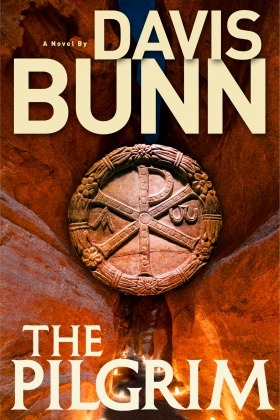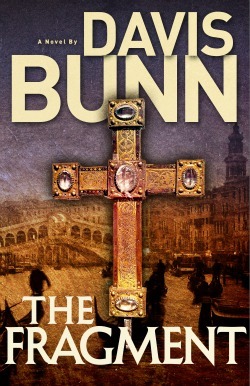How to Use âThe Pilgrimâ as a Teaching Tool
 In her review of The Pilgrim, Cindy Anderson — a self-described older adult, avid reader, and former homeschooling parent — examines the novel from a variety of perspectives. I particularly like Cindy’s tips for how teachers can create a unit study of The Pilgrim that covers the Bible, geography, history, and language arts. Well done, Cindy!
In her review of The Pilgrim, Cindy Anderson — a self-described older adult, avid reader, and former homeschooling parent — examines the novel from a variety of perspectives. I particularly like Cindy’s tips for how teachers can create a unit study of The Pilgrim that covers the Bible, geography, history, and language arts. Well done, Cindy!
Cindy Anderson, on her blog:
The Pilgrim, by Davis Bunn, is a thought provoking narrative that deals with acceptance, forgiveness, and faith. While the book is a work of fiction, and therefore should not be viewed with a mind toward theological debates, these three aforementioned aspects of life are some that we all, in our own way, battle with daily. Sometimes the battle goes on for years depending on the extent of the damage done and our ability to overcome circumstances beyond our control.
As an older adult, I can relate well with the characters and several of their plights. Being able to empathize with a character allows the reader to better identify with the subject matter, and therefore determine whether or not they themselves need to deal with similar issues in their own life.
The author does a very good job of helping the reader realize that knowing one ought to forgive someone and being able to do so do not always go hand in hand, at least not immediately. Even though the main characters in The Pilgrim are Christians, they are shown to not be perfect and to struggle with the events in their lives that have hurt them deeply and permanently changed their futures.
While true Christians are told to forgive, they must realize that forgetting can be much more difficult, and often seems impossible. Reliving over and over again the event(s) that caused the pain is what tends to make forgiving so difficult.
The characters in this book were not immune to the consequences of rehashing events that could not be changed but which must be dealt with and endured. Remorse, self-doubt, self-pity, and the persistent “what if” question is shown to do nothing to further the characters healing process or their spiritual growth.
Each character in this book, beginning with Helena, works through the process of accepting his or her new set of circumstances, with coming to terms with their need to forgive those who were seen to have caused them pain, including God in Anthony’s case, and has their faith tested to the nth degree.
While only those with a very good knowledge of history would be able to discern whether or not the events and geographical descriptions are accurate, almost anyone who reads this book will be able to understand the turmoil that the actions of others, or life occurrences, can cause in one’s life making the storyline much more believable because of the reader’s ability to identify with one or more of the characters within its pages.
As an avid reader, I enjoyed The Pilgrim and was personally challenged to follow the examples of its characters, a task that’s almost always easier said, or in this case written about, than done.
How to use The Pilgrim as a teaching tool
As a former homeschooling parent, I can easily see this book being used as a unit study covering Bible, geography, history, and language arts.
Advanced students could also use it to study sociology and some areas of psychology. The student can research the various historical events mentioned, trace the journey and learn about the different cities and cultures of the area, not to mention the cuisine for those who enjoy learning and executing that subject matter, and look into the lives of the different characters mentioned such as Constantine and his mother Helena to determine how much of what they’ve read in this book is true and how much has been added by the author. That exercise alone would be an excellent way to learn “the rest of the story” as Paul Harvey would say.
To end their unit study, the student would write a book report and/or essay(s) based on their research of the subject matter. There is enough material here to structure into either a one semester study or a full year study as determined by the parent/teacher.
Whatever your reason for reading The Pilgrim, I have no doubt that you will find it to be not only an interesting and enjoyable read but also one that will challenge and enlighten you. It will help you to deal with your own need to forgive and move on or possibly better understand someone you know who is having a difficult time forgiving and accepting their new normal.
In the event that the latter is the case, this book would be an excellent gift choice for that friend or acquaintance and may lead to fruitful discussions whereby you can help and encourage them to move forward and past their circumstances.
 Coming Next:
The Fragment
Coming Next:
The Fragment
This followup to The Pilgrim releases February 19, 2016. Here’s a preview:
It’s 1923, and a resilient Paris is starting to recover from the ravages of World War I and the Spanish Flu epidemic.
Enter Muriel Ross, an amateur photographer tasked with documenting the antiques that her employer, U.S. Senator Tom Bryan, has traveled to France to acquire.
Although she’s exhilarated to have escaped her parents and the confines of their stifling Virginia home, Muriel has lingering questions about why the senator has chosen her for this grand adventure. Nevertheless, she blossoms in her new surroundings, soaking up Parisian culture and capturing the sights and sounds of Paris on her camera.
But events take a dangerous turn when she discovers that the senator is on a mission far more momentous—and potentially deadly—than a mere shopping trip.
At the Cathedral of Notre Dame, Senator Bryan asks Muriel to photograph an astonishing artifact: a piece of the True Cross, discovered by Empress Helena—a historical figure familiar to readers of The Pilgrim.
When rumors surface that another fragment has been unearthed, Muriel becomes enmeshed in a covert international alliance dedicated to authenticating the fragment—and protecting it from those who will stop at nothing to steal and discredit it.
Click here to pre-order The Fragment from your favorite online bookseller.









